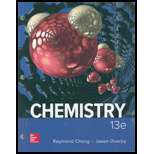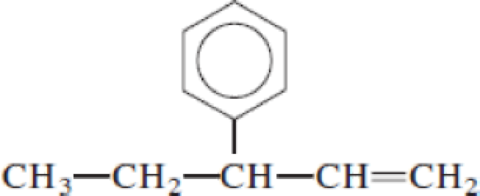
Concept explainers
Name the following compounds:




- (a) CH3─C≡C─CH2─CH3

a)
Interpretation:
The given structure has to be named.
Concept introduction:
IUPAC Nomenclature:
- The longest continuous chain of carbon atoms is identified.
- The substituent groups attached to the parent chain is identified. A substituent group contains group of atoms attached to the carbon atom of the chain.
- While numbering the longest chain, the substituent should get least possible number.
- Write the name of the compound; the parent name written as last part of the name. The name of the substituents is written as prefix and a hypen separates the number that the substituents attached with carbon. More than one substituent should be written in alphabetical order.
Explanation of Solution
Given structure:

Predict the longest continuous chain of carbon atoms:

The longest continuous carbon chain of carbon atoms contains five carbons and the parent name is PENTANE. The Suffix ‘ane’ represents the structure contains only single bonds.
Predict substituents and its location:

At each Carbon of 2 one methyl group is present. Hence, the structure containing one substituents, then prefix ‘2-methyl’ is added before the parent name. Hyphen separates the number that the substituent attached with carbon.
IUPAC name: 2-methylpentane.
b)
Interpretation:
The given structure has to be named.
Concept introduction:
IUPAC Nomenclature:
- The longest continuous chain of carbon atoms is identified.
- The substituent groups attached to the parent chain is identified. A substituent group contains group of atoms attached to the carbon atom of the chain.
- While numbering the longest chain, the substituent should get least possible number.
- Write the name of the compound; the parent name written as last part of the name. The name of the substituents is written as prefix and a hypen separates the number that the substituents attached with carbon. More than one substituent should be written in alphabetical order.
Explanation of Solution
Given structure:

Predict the longest continuous chain of carbon atoms:

The longest continuous carbon chain of carbon atoms contains five carbons and the parent name is PENTANE. The Suffix ‘ane’ represents the structure contains only single bonds.
Predict substituents and its location:

At each Carbon of 2, 3, and 4 one methyl group is present. Hence, the structure containing three identical substituents, then prefix ‘2,3,4-trimethyl’ is added before the parent name. Hyphen separates the number that the substituent attached with carbon.
IUPAC name: 2,3,4-trimethylpentane.
c)
Interpretation:
The given structure has to be named.
Concept introduction:
IUPAC Nomenclature:
- The longest continuous chain of carbon atoms is identified.
- The substituent groups attached to the parent chain is identified. A substituent group contains group of atoms attached to the carbon atom of the chain.
- While numbering the longest chain, the substituent should get least possible number.
- Write the name of the compound; the parent name written as last part of the name. The name of the substituents is written as prefix and a hyphen separates the number that the substituents attached with carbon. More than one substituent should be written in alphabetical order.
Explanation of Solution
Given structure:

Predict the longest continuous chain of carbon atoms:

The longest continuous carbon chain of carbon atoms contains six carbons and the parent name is HEXANE. The Suffix ‘ane’ represents the structure contains only single bonds.
Predict substituents and its location:

At each Carbon of 3 one ethyl group is present. Hence, the structure containing one substituent, then prefix ‘3-ethyl’ is added before the parent name. Hyphen separates the number that the substituent attached with carbon.
IUPAC name: 3-ethylhexane.
d)
Interpretation:
The given structure has to be named.
Concept introduction:
IUPAC Nomenclature:
- The longest continuous chain of carbon atoms is identified.
- The substituent groups attached to the parent chain is identified. A substituent group contains group of atoms attached to the carbon atom of the chain.
- While numbering the longest chain, the substituent should get least possible number.
- Write the name of the compound; the parent name written as last part of the name by replacing ‘ane’ to ‘ene’. The name of the substituents is written as prefix and a hyphen separates the number that the substituents attached with carbon. More than one substituent should be written in alphabetical order.
Explanation of Solution
Given structure:

Predict the longest continuous chain of carbon atoms:

The longest continuous carbon chain of carbon atoms contains five carbons and the parent name is 1,4-PENTDIENE. The Suffix ‘diene’ represents the structure contains two double bonds at C-1 and C-4.
Predict substituents and its location:

At each Carbon of 3 one methyl group is present. Hence, the structure containing one substituent, then prefix ‘3-methyl’ is added before the parent name. Hyphen separates the number that the substituent attached with carbon.
IUPAC name: 3-methyl-1,4-pentadiene.
e)
Interpretation:
The given structure has to be named.
Concept introduction:
IUPAC Nomenclature:
- The longest continuous chain of carbon atoms is identified.
- The substituent groups attached to the parent chain is identified. A substituent group contains group of atoms attached to the carbon atom of the chain.
- While numbering the longest chain, the substituent should get least possible number.
- Write the name of the compound; the parent name written as last part of the name by replacing ‘ane’ to ‘yne’. The name of the substituents is written as prefix and a hypen separates the number that the substituents attached with carbon. More than one substituent should be written in alphabetical order.
Explanation of Solution
Given structure:

Predict the longest continuous chain of carbon atoms:

The longest continuous carbon chain of carbon atoms contains five carbons and the parent name is PENT-2-YNE. The Suffix ‘2-yne’ represents the structure contains one triple bond at C-2.
Predict substituents and its location:

No substituents present and no prefix can be written. Hence, the name is,
IUPAC name: Pent-2-yne.
f)
Interpretation:
The given structure has to be named.
Concept introduction:
IUPAC Nomenclature for alkene:
- The longest continuous chain of carbon atoms is identified.
- The substituent groups attached to the parent chain is identified. A substituent group contains group of atoms attached to the carbon atom of the chain.
- While numbering the longest chain, the double bond should get least possible number.
- Write the name of the compound; the parent name written as last part of the name by replacing ‘ane’ to ‘ene’. The name of the substituents is written as prefix and a hypen separates the number that the substituents attached with carbon. More than one substituent should be written in alphabetical order.
Geometric isomers of Alkenes:
Cis-isomer: When two particular atoms (group of atoms) are adjacent to each other, the alkene is known as cis-isomer.

Trans-isomer: When two particular atoms (group of atoms) are across from each other, the alkene is known as cis-isomer.
Explanation of Solution
Given structure:

Predict the longest continuous chain of carbon atoms:

The longest continuous carbon chain of carbon atoms contains five carbons and the parent name is PENT-1-ENE. The Suffix ‘1-ene’ represents the structure contains one double bond at C-1.
Predict substituents and its location:

At each Carbon of 3 one phenyl group is present. Hence, the structure containing one substituent, then prefix ‘3-phenyl’ is added before the parent name. Hyphen separates the number that the substituent attached with carbon.
IUPAC name: 3-phenylpent-1-ene.
Want to see more full solutions like this?
Chapter 24 Solutions
CHEMISTRY (LOOSELEAF) >CUSTOM<
- Understanding the general acid-base properties of amino acids O Proteins Imagine each of the molecules shown below was found in an aqueous solution. Can you tell whether the solution is acidic, basic, or neutral? molecule The solution is... 010 H3N-CH-C-OH CH HO CH3 O acidic O basic neutral O (unknown) H3N HO 0 O acidic O basic neutral ○ (unknown) H3N-CH-C-O CH2 CH3-CH-CH3 O acidic O basic Oneutral ○ (unknown) O= X H2N-CH-C-O CH3 CH CH3 acidic O basic O neutral ○ (unknown) ? 000arrow_forwardImagine each of the molecules shown below was found in an aqueous solution. Can you tell whether the solution is acidic, basic, or neutral? molecule 0=0 H3N-CH-C-o HO CH2 OH The solution is... O acidic O basic O neutral O (unknown) H₂N acidic O basic O neutral ○ (unknown) + H3N O OH O acidic O basic O neutral O (unknown) H2N-CH-C-O CH3 O acidic O basic neutral ○ (unknown) X ? olo HEarrow_forwardRecognizing ampli Draw an a amino acid with a methyl (-CH3) side chain. Explanation Check Click and drag to start drawing a structure. X Carrow_forward
- Write the systematic name of each organic molecule: structure name × HO OH ☐ OH CI CI O CI OH OHarrow_forwardく Check the box under each a amino acid. If there are no a amino acids at all, check the "none of them" box under the table. Note for advanced students: don't assume every amino acid shown must be found in nature. COO H3N-C-H CH2 HO CH3 NH3 O CH3-CH CH2 OH Onone of them Explanation Check + H3N O 0. O OH + NH3 CH2 CH3-CH H2N C-COOH H O HIC + C=O H3N-C-O CH3- - CH CH2 OH Х 2025 McGraw Hill LLC. All Rights Reserved. Terms of Use | Privacy Center Accesarrow_forwardWrite the systematic name of each organic molecule: structure HO-C-CH2-CH3 O -OH CH3-CH2-CH2-CH2-CH2-C-OH CH3 CH3-CH-CH2-C-OH Explanation Check S namearrow_forward
- theres 2 productsarrow_forwardDraw the major product of this solvolysis reaction. Ignore any inorganic byproducts. + CH3CH2OH Drawing Q Atoms, Bonds and Rings OCH2CH3 || OEt Charges OH 00-> | Undo Reset | Br Remove Done Drag To Pan +arrow_forwardDraw the major product of this SN1 reaction. Ignore any inorganic byproducts. CH3CO2Na CH3CO2H Drawing + Br Q Atoms, Bonds and Rings OAC Charges OH ОАс Na ဂ Br Undo Reset Remove Done Drag To Pan +arrow_forward
- Organic Functional Groups entifying positions labeled with Greek letters in acids and derivatives 1/5 ssible, replace an H atom on the a carbon of the molecule in the drawing area with a ce an H atom on the ẞ carbon with a hydroxyl group substituent. ne of the substituents can't be added for any reason, just don't add it. If neither substi er the drawing area. O H OH Oneither substituent can be added. Check D 1 Accessibility ado na witharrow_forwardDifferentiate between electrophilic and nucleophilic groups. Give examples.arrow_forwardAn aldehyde/ketone plus an alcohol gives a hemiacetal, and an excess of alcohol gives an acetal. The reaction is an equilibrium; in aldehydes, it's shifted to the right and in ketones, to the left. Explain.arrow_forward
 ChemistryChemistryISBN:9781305957404Author:Steven S. Zumdahl, Susan A. Zumdahl, Donald J. DeCostePublisher:Cengage Learning
ChemistryChemistryISBN:9781305957404Author:Steven S. Zumdahl, Susan A. Zumdahl, Donald J. DeCostePublisher:Cengage Learning ChemistryChemistryISBN:9781259911156Author:Raymond Chang Dr., Jason Overby ProfessorPublisher:McGraw-Hill Education
ChemistryChemistryISBN:9781259911156Author:Raymond Chang Dr., Jason Overby ProfessorPublisher:McGraw-Hill Education Principles of Instrumental AnalysisChemistryISBN:9781305577213Author:Douglas A. Skoog, F. James Holler, Stanley R. CrouchPublisher:Cengage Learning
Principles of Instrumental AnalysisChemistryISBN:9781305577213Author:Douglas A. Skoog, F. James Holler, Stanley R. CrouchPublisher:Cengage Learning Organic ChemistryChemistryISBN:9780078021558Author:Janice Gorzynski Smith Dr.Publisher:McGraw-Hill Education
Organic ChemistryChemistryISBN:9780078021558Author:Janice Gorzynski Smith Dr.Publisher:McGraw-Hill Education Chemistry: Principles and ReactionsChemistryISBN:9781305079373Author:William L. Masterton, Cecile N. HurleyPublisher:Cengage Learning
Chemistry: Principles and ReactionsChemistryISBN:9781305079373Author:William L. Masterton, Cecile N. HurleyPublisher:Cengage Learning Elementary Principles of Chemical Processes, Bind...ChemistryISBN:9781118431221Author:Richard M. Felder, Ronald W. Rousseau, Lisa G. BullardPublisher:WILEY
Elementary Principles of Chemical Processes, Bind...ChemistryISBN:9781118431221Author:Richard M. Felder, Ronald W. Rousseau, Lisa G. BullardPublisher:WILEY





